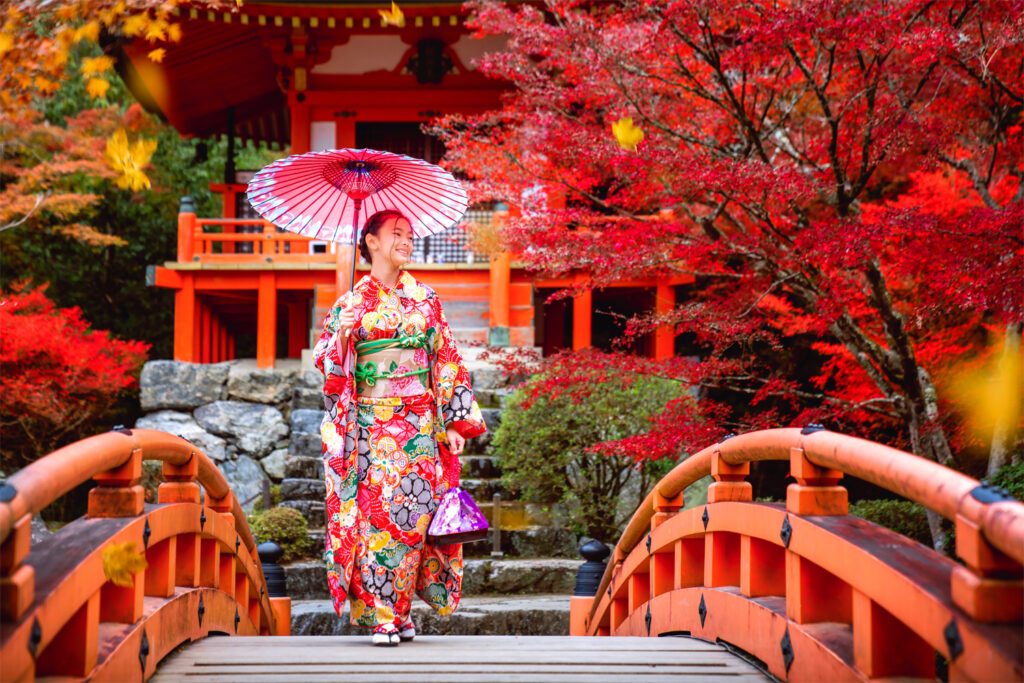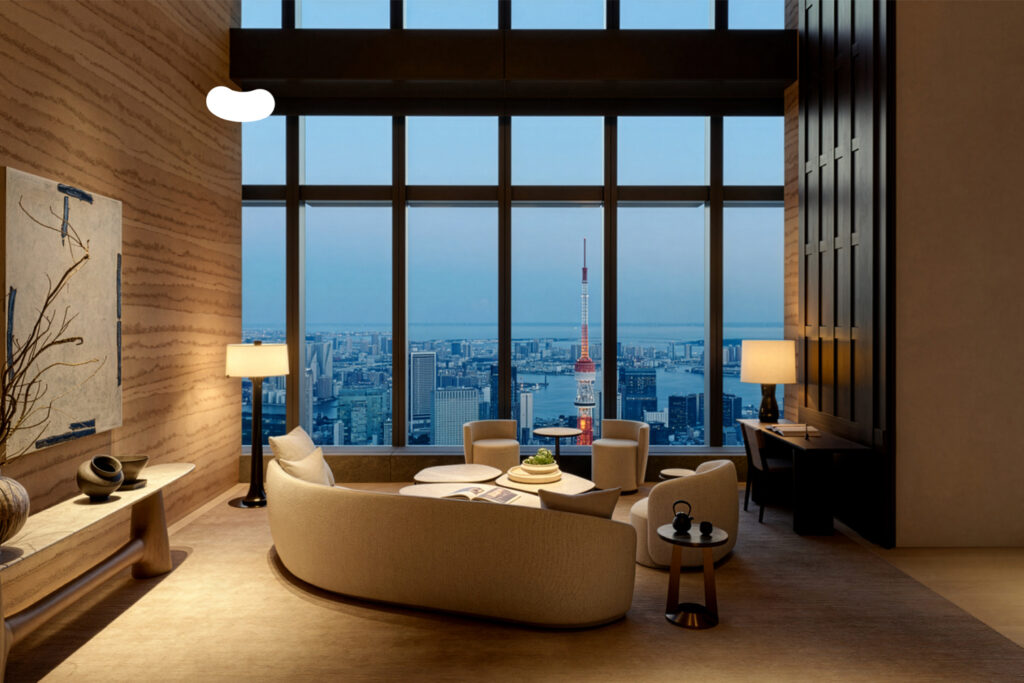
Many people looking at Japanese property for the first time – either as a renter or buyer – are not aware that there are differences between their home country in the typical room types and their intended purposes. This article explores some of the most common features and introduces major differences between Japan and abroad.
Features Traditional Japanese Home of the home
Living Room

The first area we will look at is the living room. Please look at the floor plan of a typical one-storey house above. There is 1 bedroom, an i-ma (Japanese style living room), a kyaku-ma (Japanese style guest room), a kitchen and a bathroom in this house. Each room is separated by walls or fusuma (paper-covered slide doors and partitions). Most people are reminded of the Showa era (1926–1989) when seeing this typical Japanese-style house.
It is said that Japanese-style residences these days are based upon the Shoin-zukuri style from the Muromachi era (1336–1573), which was the turning point when aristocratic society turned into samurai society. Shoin-zukuri was a residence as well as a workplace of samurai, and since they regularly engaged in deal-making and negotiations to expand their power, their residences needed to have a public space for meeting people and a private space for their daily life. The typical Japanese house features traditional tatami flooring, sliding paper doors called shoji, and a distinct minimalist design aesthetic that showcases harmony with nature.
The Kitchen

The kitchen in a typical Japanese home often combines traditional elements with modern appliances. While older homes may feature a “kamado” (traditional Japanese stove), newer homes are equipped with state-of-the-art kitchen systems. The layout often includes a separate area for food preparation and cooking, distinct from the dining area. Ovens are still relativly rare in Japanese homes but sometimes come with Fish Grills.
Bathroom
The second area is the bathroom. In foreign countries, a bathtub and toilet tend to be put in the same room and in many cases, there are multiple bathrooms, so some foreigners wonder why there is only 1 bathroom and 1 toilet in Japanese houses.
A bathtub and toilet were traditionally separated in Japan because the bathroom is considered to be not only the place to wash but also the place to relax in a hot water filled bathtub. People considered the toilet as dirty and did not want to have it next to the bathtub. Thanks to the separation of the bathroom and toilet, there is less need to queue when nature calls. In the Edo era (1603–1868), it was common for the bathroom and toilet to be installed in different buildings outside of the house and to be shared with extended family members.
Hot water was also shared with family members and that is the reason why Japanese bathrooms are wetrooms, separated into a bathtub and a place to wash. People washed themselves then used the bathtub to soak, thereby keeping the water clean for other family members. Outside of Japan, the bathroom is often considered to be a private/individual space and is not something to be shared. Even if the bathtub is full of hot water, the water is generally only used once as washing takes place inside the tub.
Japanese toilets are also unique with many having a built in Bidet. They can also have may other functions such as heated seats, self-cleaning functionality and perfume dispensers to remove odors.
Tatami Rooms

Tatami rooms are another unique feature of Japan home layouts. These rooms are floored with tatami mats and are versatile spaces used for various purposes, such as meditation, tea ceremonies, or as guest rooms. The tatami room often adjoins the i-ma, providing a seamless blend of public and private spaces. These are becoming rarer as less and less new buildings include them, in favour of a second guest bedroom or larger living space.
Balconies and Verandas
Japanese homes, especially in urban areas, are known for their efficient use of space. Balconies and verandas are common features that serve multiple purposes, from drying clothes to creating a small garden. These outdoor spaces are often considered an extension of the living area. You can see walking around residential buildings in Tokyo that most of them have balconies, many more than other major cities.
Storage Solutions
Japanese homes are renowned for their clever storage solutions. From “oshiire” (closet spaces for futons) to built-in cabinets, every nook and cranny is utilized to maximize storage. This is particularly important in Japan, where living spaces are often smaller compared to Western standards. See this article on Japanese apartments and how best to utilise the space -> Here
Flooring Materials
While tatami mats are traditional, modern Japanese homes often feature a variety of flooring materials. Hardwood floors, carpets, and tiles are commonly used, each serving specific functional and aesthetic purposes.
Ceiling Height
The last area to consider is the ceiling height. The average ceiling height in Japan used to be 220cm because people generally sat on tatami mats and the ceiling height was decided based on the eye level. As Japanese houses became more westernized, people’s lifestyles also changed and tatami was replaced by chairs and flooring. The most common ceiling height in Japan is 240 cm and takes into consideration the efficiency of air conditioning and the average height of Japanese etc. This can be lower than abroad, for example, the standard ceiling height in the US is 8-9 feet (243-274 cm). In more luxurious housing in Japan these celling heights can be much higher, sometimes up to 3 meters.
Trend towards Westernization
Overseas, the living room is located close to the entrance of a house and visitors are shown into the living room first. Sofas and tables are placed in the living room, so this is where hosts welcome visitors. Additionally, the living room is often a hub of family life.

In contract to foreign residences, the functions of a Japanese living room is divided into i-ma (private space) and kyaku-ma (public space). Visitors can see the hallway first after going through the entrance, and the other private spaces are generally hidden. I-ma is considered to be a private space where family members can be themselves so that it tends to be located in the farthest from the entrance.
With the westernization of Japanese housing, there was a trend toward people choosing houses with an ousetsu-ma (guest room) rather than a kyaku-ma (Japanese-style public space). Nowadays, however, people think they don’t even need guest room much because they don’t often have guests, and they would rather use that space for other purposes, therefore the number of houses without guest room is increasing recently. Nowadays the border between the living room and Japanese-style i-ma is becoming more and more obscure.

There is also a trend towards contemporary Japanese homeowners adapting traditional layouts to suit modern lifestyles, possibly integrating open-plan concepts or multifunctional spaces.
Technological Innovations
With Japan being at the forefront of technology, it’s no surprise that smart home systems are increasingly popular. From advanced security systems, that use facial recognition, to home automation, technology is integrated into the very fabric of Japan home layouts. This could include smart home appliances such as a coffee machine that could turn on and brew your coffee in the morning ready for when you wake up, or refrigerators that can track what is in the fridge.
Energy Efficiency
As sustainability becomes a global concern, energy-efficient designs are becoming more prevalent in Japan home layouts. Features like double-glazed windows and advanced insulation techniques, which help reduce the escaping of hot air in the winter and the loss of cold air in the summer, meaning less energy is wasted when heating or colling a room. Also, solar panels are becoming increasingly common.
What to Consider When Choosing a Home in Japan
- Understand the historical and cultural influences on Japan home layouts.
- Consider your needs for public and private spaces.
- Take note of unique features like tatami rooms and advanced storage solutions.
- Keep an eye out for modern amenities and technological innovations.
- Evaluate the energy efficiency and sustainability features of the home.
- Japanese home layout typically prioritizes simplicity, functionality, and a harmonious blend with nature. Traditional elements such as tatami mats, sliding doors (fusuma), and open spaces (ma) are common in the design, promoting a seamless flow between different areas of the house.
If you’re interested in a Western-style home in Japan, Housing Japan has extensive experience in sourcing these types of properties. We have also produced Western-style luxury houses in central Tokyo, including Gravitas Akasaka, Gravitas Minamiazabu, and Zenith Akasaka.
By understanding the nuances of Japan home layouts, you can make a more informed decision when choosing a property that suits your lifestyle and needs.












